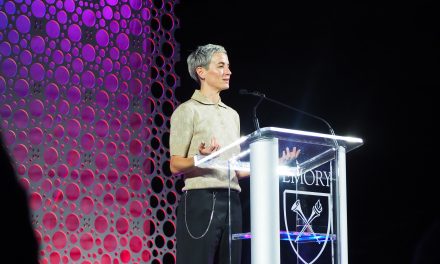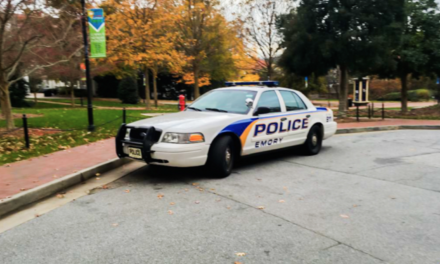This article is part of an ongoing series about the sequester’s effects on Emory University. Last week, the Wheel looked at its effects on financial aid programs. Next Week: The sequester’s impact on Emory Healthcare.
College junior Sanket Shah, who works in a lab on campus, was planning to ask his boss for a raise next year. But as a result of the sequester, a series of automatic federal spending cuts that took effect March 1, it’s looking less and less likely that he’s going to be able to do so.
“I’ve been working there for two years,” Shah said. “Now I know for sure I can’t ask for that.”
Shah is currently a peer mentor in the Scholarly Inquiry and Research at Emory (SIRE) Research Partners program, which pairs students with faculty researchers and allows them to serve as research assistants.
Because peer mentors must also be involved in their own research, Shah is a paid employee at the Children’s Center, which receives funding through grant money. And for students like Shah who receive federal funds in their salary, there might be cause for concern.
Like Shah, many student and faculty researchers will soon feel the impacts of the sequester, which will likely lead to reductions in federal funding for research at colleges and universities across the country, including at Emory. On a federal level, there will be a 5 percent cut to federal research funding.
For Emory, this means a $17.5 million reduction, according to Director of Federal Affairs Cameron Taylor, who detailed the potential impacts of the sequester on University research in a March 5 Emory Report article.
Emory received $350 million in federal grants during the 2011-2012 academic year.
The College specifically received about $21.5 million in federal funding for Fiscal Year (FY) 2012, which ended Aug. 31.
“The cuts are across the board,” said Raymond Dingledine, a professor and chair of the Department of Pharmacology at the School of Medicine. “Every laboratory and every research faculty member will feel this. Every research program will have to find a way forward with fewer resources.”
David Stephens, the vice president for research at the Woodruff Health Sciences Center, specified in an interview with the Wheel that the funding decline “could be more or less [than the $17.5 million projected reduction], depending on how research grants fair in the system.” The sequester, he said, could lead to a loss of jobs in research or cutbacks on programs, though the exact implications are not yet known.
Federal Grant Funding Reduction
Federal grants are often funded for a period of roughly four years, Stephens said.
So, grants that continue through the sequester will see an approximately five-percent reduction. New grants will likely see about a 10-percent decrease.
Twenty-four federal agencies – including the National Institutes of Health (NIH) and the Centers for Disease Control (CDC), among others – partnered with researchers at the University last year.
In the “NIH Operation Plan in the Event of a Sequestration” statement on its website, NIH said: “Should a sequestration occur, NIH likely will reduce the final FY 2013 funding levels of non-competing continuation grants and expects to make fewer competing awards to allow the agency to meet the available budget allocation.”
Therefore, programs like Emory’s Summer Undergraduate Research Experience (SURE) that pay researchers, in part, through federal grants will probably face negative consequences, though at this time the exact changes are unknown.
“It’s likely that many labs will encounter some reduction in funding, which will moderately impact graduate and undergraduate research opportunities,” Gary Bassell, a SURE mentor in cell biology and a professor of cell biology, wrote in an email to the Wheel.
Funding for SURE comes from grants from partners such as the Howard Hughes Medical Institute (HHMI), according to the program’s website. But many individual professors also use federal grant awards to supplement this HHMI funding in order to open more slots for undergraduates in SURE.
“It’s very difficult – if you’re a new investigator, a faculty member or student looking to the future – not to say, ‘Gosh, that’s not a very pretty picture for research,'” Stephens said. “I really am concerned about the junior, young investigators, those who are pursuing research careers.”
Funding for SIRE research grants, though, will not be directly affected, according to Leah Roesch, Emory’s SIRE director. These grants, she explained, receive funds from the College and a variety of outside donations, not from federal grants impacted by the sequester.
Still, the sequester could have a “trickle-down effect” on SIRE students.
“Certainly if the professor’s grants get too tight, they may have to let go of staff or not do ‘side’ projects which are sometimes the best mentors and projects for undergraduates,” Roesch wrote in an email to the Wheel.
Facing the Shortfall
Dingledine said the School of Medicine in particular expects a shortfall of $14.2 million as a result of the sequester.
This decrease will consist of $3.7 million in indirect costs that the Dean uses to support administrative, research and teaching functions of the medical school; and $10.5 million of direct costs that School of Medicine investigators in the School of Medicine use to fund laboratory-based clinical or basic research programs.
“We’re scrambling within the School of Medicine to figure this all out,” Dingledine said, in reference to determining future faculty and research funding.
Dingledine said that because most research awards from the National Institutes of Health (NIH) are backloaded toward the end of their respective fiscal years, most of the shortfall will take place starting during the summer and fall.
He added that NIH funds account for about 70 percent of research funding at the School of Medicine.
“This is a particularly hard nut to crack,” he said.
In addition, Dingledine clarified that many of the basic sciences departments like Biochemistry and Human Genetics will be “unusually hard-hit” because research awards comprise a larger portion of their overall funding.
Meanwhile, the Yerkes National Primate Research Center will feel the financial effects of the sequester, too. Stuart Zola, the Center’s director, wrote in an email to the Wheel that Yerkes has a large number of NIH-funded grants.
In reference to what he sees as the great impacts of the sequester, Zola wrote: “Decreased morale in some. Increased sense of challenge, energy and intent to meet the challenge in others.”
In response to the challenges the sequester is presenting, Dingledine and School of Medicine department chairs have been discussing the effects of the sequester at strategy meetings.
“I think we’ll find out a way through this, but it will require a culture change within Emory,” Dingledine said. “I think we will move from a go-go growth into a value-seeking mode, and that won’t be easy. Any fundamental culture change is difficult.”
Stephens said he feels numerous efforts are currently underway to “try and make the case for research in terms of its value to not only Emory but also to the nation.”
As for Shah, he went from volunteering in the lab to earning a salary through the Research Partners program just last year.
For many students, though, that same process in already competitive research programs may become more difficult.
But for now, there’s a sense of uncertainty about the exact implications of the sequester on research among students and faculty.
“I figure once we get closer to summer, I’ll ask about funding,” Shah said. “I’m not sure what’s taking place yet.”
– By Jordan Friedman
Updated April 2 at 11:50 a.m. to provide additional information and clarification about the Howard Hughes Medical Institute.
The Emory Wheel was founded in 1919 and is currently the only independent, student-run newspaper of Emory University. The Wheel publishes weekly on Wednesdays during the academic year, except during University holidays and scheduled publication intermissions.
The Wheel is financially and editorially independent from the University. All of its content is generated by the Wheel’s more than 100 student staff members and contributing writers, and its printing costs are covered by profits from self-generated advertising sales.






Really glad to see the Wheel covering the impact of the sequester on students, faculty, and academic research at Emory. It is a big deal. I would hate to see Emory’s undergraduate and graduate students left in the cold because our labs are unable to support them through hands-on training.
One point of clarification: the Howard Hughes Medical Institute is a private non-profit organization, so it is not associated with the federal government and will not be directly impacted by the sequester.
You know what the sequester won’t reduce?
Wagner’s salary.